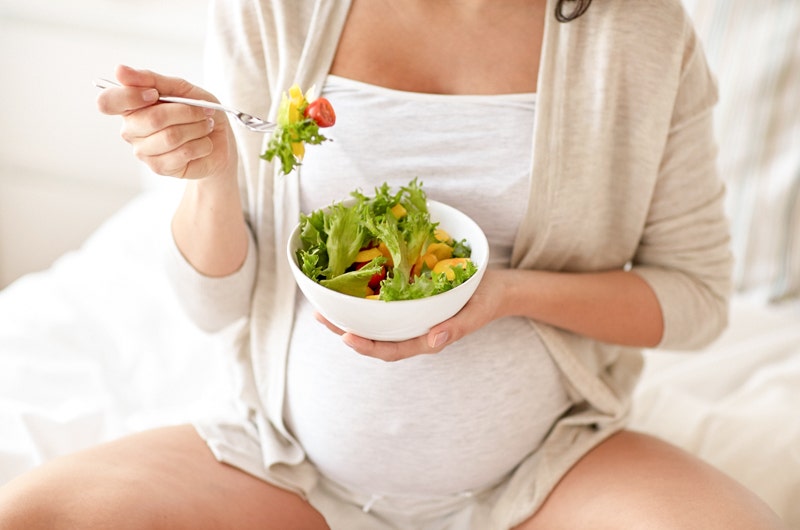Many physiological changes occur in the body during pregnancy, and being physically active during pregnancy and following a proper diet has been shown to pose little risk to the mother and baby - if there are no pregnancy-related complications.
During pregnancy, exercise can help maintaining health and fitness levels, help with weight management, reduce the incidence of gestational diabetes, and improve psychological health.
It has also been shown that postpartum physical activity can promote weight loss, particularly with regard to body fat added during pregnancy, as well as, improve fitness levels and psychological well-being without affecting the production of milk needed for breastfeeding.

Other often overlooked factors relate to the consequences of pregnancy on the musculoskeletal system. As the belly expands, the abs lengthen and the back muscles shorten. The connective tissue in the linea alba thins and separates. The ligaments and joints of the pelvis become very unstable and the pelvic floor often weakens under the weight of the fetus, furthermore, breastfeeding, lifting and carrying a baby can lead to kyphosis, making the human body more susceptible to injury.
With the postpartum recovery period also comes a series of physical changes that alter both aesthetics and health.
Most doctors advise women experiencing pregnancy to wait 4-8 weeks before resuming exercise, some leading international medical associations the American College of Obstetricians and Gynecologists (ACOG) say it's okay to gradually resume exercise after childbirth when mom feels ready.
In addition to training programs, proper nutrition is a great help to make sure that everything goes smoothly during pregnancy, the basic principles of a healthy diet remain the same: eat lots of fruit, vegetables, whole grains, Protein lean and healthy fats. However, some nutrients in a pregnant diet deserve special attention - let's see them below.
Folic acid
It is a synthetic form of folate found in supplements and fortified foods: it is known as folic acid. Folic acid supplementation has been shown to reduce the risk of premature birth and having a low birth weight baby.

Fortified cereals are excellent sources of folic acid. Dark green leafy vegetables, citrus and dried beans, peas and lentils are good sources of natural folate. From the point of view of a possible integration from 600 micrograms to 1000 micrograms they represent a good solution if deemed necessary by the doctor.
Calcium
In addition to supporting bone structures and teeth, calcium also supports the proper functioning of the circulatory, muscular and nervous systems.

Dairy products are certainly the sources of calcium with a better assortment to these are added some vegetables such as broccoli and cabbage as well as a whole series of fortified products a right amount of intake during pregnancy should be 1300 mg per day.
Protein
Adequate protein intake during pregnancy is important for maintaining maternal health during pregnancy and for providing important building blocks for fetal growth and development.

Protein provide the building block for the body, are an integral part of the immune system, carry substances throughout the body, are the basis of many hormones and enzymes, and maintain fluid balance. Pregnant women need a minimum of 60g of protein per day. Good sources of dietary protein include meat, poultry, fish, dairy, legumes, beans, and nuts.
Physical activity and pregnancy
As stated at the outset, a regular exercise plan is another key component of weight management. Pregnant women should consult with their doctor before starting an exercise program or changing their existing regimen to rule out complications. Light to moderate physical activity does not adversely affect fetal development for a normal, uncomplicated pregnancy. A properly designed exercise program during pregnancy is beneficial and can contribute to healthy weight management right now.
According to physical activity guidelines published by the U.S. Department of Health and Human Services, it is recommended that healthy pregnant women should perform at least 150 minutes per week of moderate-intensity aerobic activity, such as brisk walking, during and after pregnancy, spreading the activity over the week. Healthy women who already do vigorous intensity aerobic activity, such as running, or large amounts of activity can continue to do so during and after pregnancy, as long as they stay healthy and discuss with their doctor how and when to do the activity. time should be adjusted.
Weight training can be done during pregnancy; however, safety is a key factor. In the second and third trimester the exercises should not be performed in the supine position and if a woman completes more than one set of each exercise, the rest period between sets should be longer (2-4 minutes), to allow for recovery. sources of energy and heart rate.
A variety of weight training exercises can be performed using machines, free weights, rubber bands, bungee tubes, and in some cases simply body weight. However, the use of some machines may be a limitation as their design may be less fitting to the pregnant woman's body. Furthermore, for reasons explained above, it is possible to perform exercises with weights also for the back, to improve posture and maintain pelvic alignment - since the uterus and breast tissue widen by moving the center of gravity forward -.
To conclude, in addition to adequate caloric and nutritional intake, and appropriate exercise and physical activity, various lifestyle factors should be considered when planning for adequate weight gain during pregnancy. Employment, recreational activities, stress level, and habitual dietary behaviors (e.g., eating out, cues for eating, binging) are important considerations for weight management programs.
WARNING Any changes in diet or training during pregnancy should be discussed with your physician or licensed healthcare professional The information given in this article is provided for informational purposes only.
Bibliography
Chicago Dietetic Association SSDA, Dietitians of Canada (2000) Pregnancy. In: Berzy D, Mehta A (eds) Manual of clinical dietetics, 6th edn. American Dietetic Association, Chicago, Ill.
American College of Obstetrics and Gynecology (2002) Opinion no. 267: Exercise during pregnancy and the postpartum period. Obstet Gynecol. 99:171–173
Clapp JF III, Little KD (1995) Effect of recreational exercise on pregnancy weight gain and subcutaneous fat deposition. Med Sci Sports Exerc 27:170–175
Layman DK, Evans E, Baum JI, Seyler J, Erickson DJ, Boileau RA (2005) Dietary protein and exercise have additive effects on body composition during weight loss in adult women. J Nutr 135:1903–1910
McArdle WD, Katch FI, Katch VL (2001) Exercise physiology: energy nutrition and human performance, 5th edn. Lippincott Williams & Wilkins, New York, N.Y.
Weissgerber T, Wolfe L, Davies G, Mottola M (2006) Exercise in the prevention and treatment of maternal-fetal disease: A review of the literature. Appl Physiol Nutr Metab 31:661–674
U.S. Department of Health and Human Services.
2008 Physical Activity Guidelines for Americans.
Washington, DC: Department of Health and Human Services, 2008.
Centers for Disease Control and Prevention. Healthy Pregnant or Postpartum Women. 2014. www.cdc. gov/physicalactivity/everyone/guidelines/pregnancy. html. Accessed December 24, 2016.
Avery, ND, Stocking, K, Tranmer, J, Davies, G, and Wolfe, L. Fetal responses to maternal strength conditioning in late gestation. Can J Appl Physiol 24:362-376, 1999.
Piper, T, Jacobs, E, Haiduke, M, Waller, M, and McMillan, C. Core training exercise selection during pregnancy. Strength Cond J 34:55-62, 2012.
Wolfe, L. Pregnancy. In Exercise Testing and Exercise Prescription for Special Cases: Theoretical Basis and Clinical Application. Skinner, J, ed. Philadelphia: Lippincott Williams & Wilkins, 1993.


Comments
Write a comment about the article